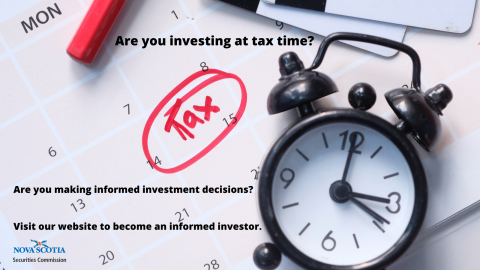Submitted by nsscadmin on

In case you needed another reminder it’s tax time. Every year at tax time the Commission delivers a few tax reminders for investors to make sure they’re not missing a few important pieces of information about taxes and credits that could apply to their investments. Specifically, we’ll be talking about the capital gains tax and the dividend tax credit for investments outside of registered or tax-free savings accounts.
Capital Gains Tax
Whenever you sell an investment for more than you paid for it, you have a capital gain. For example, if I purchase 100 shares in a stock that is valued at $5 per share and later sell those 100 shares when they’ve increased in value to $7 per share, I’ve made a $200 capital gain.
In Canada, 50 percent of your capital gains are taxable. In our example above from the $200 capital gain I made by selling my shares, $100 is taxable. That means that $100 must be added to my declared income for the year. How much tax you will end up paying on your capital gain will depend on which tax bracket you fall under.
One last thing to remember about capital gains. Only realized capital gains are taxed. To explain what this means let’s look at our $200 capital gain example again. If I continue to hold my 100 shares, they’re still worth $200 more than I originally paid for them. However, until I sell them this capital gain isn’t realized and does not need to be declared on your taxes.
Dividend Tax Credit
When it comes to dividends from shares or other investments, they are taxed differently than capital gains. Typically, dividends are taxed at your marginal tax rate which is typically more than the capital gains tax rate.
In Canada, dividends that are received from taxable Canadian corporations may be eligible for the dividend tax credit. Corporations designate their dividends as eligible or other than eligible. The tax rate for the two differ. This designation can be found on your tax slips.
When you prepare your annual tax return, you declare the grossed-up amount of your dividend income from the year as part of your overall annual income. To offset the higher amount you have declared, you can receive a tax break on your dividend income through the dividend tax credit. The tax credit is determined by federal and provincial rates, which are dependent on which province or territory in which you reside.
If you are paying tax on capital gains, dividends or some other form of investment income, be sure to discuss them with your adviser and a tax expert to ensure you are paying the correct amount of tax and taking advantage of any tax credits or breaks that may be available to you.
